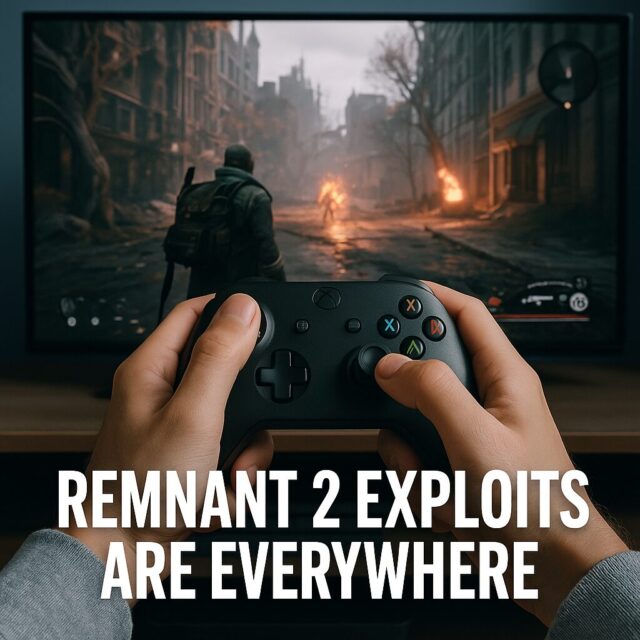On paper, Remnant 2 is everything a Soulslike co-op game should be: brutal, beautiful, and brimming with mystery. Developed by Gunfire Games, the shooter-RPG hybrid quickly became one of 2023’s breakout hits, earning praise for its atmospheric worldbuilding and endlessly replayable zones. But now, just a few months out from launch, it’s earning attention for a very different reason.
Exploits are everywhere. And players are asking: what does this mean for digital fairness?
From scrap farming macros to mid-boss checkpoint glitches, Remnant 2’s community isn’t just playing the game—they’re dissecting it. And while some see these exploits as harmless fun or clever efficiency, others say it’s eroding the core integrity of the experience.
A Game Built to Challenge—But Easy to Bend
A recent Reddit post laid out one of the most potent Apocalypse-mode exploits discovered yet: a checkpoint glitch that allows one teammate to repeatedly reset their health, cooldowns, and status effects mid-fight, without resetting the boss’s HP. The method? Surprisingly simple.
“Sit at the checkpoint and spam movement keys while your teammate dies and respawns,” the user explained. “If you walk away and it still says ‘waiting for others,’ it worked.”
The community quickly verified the exploit, with players confirming it works on bosses like Venom, Tal’Ratha, Nightweaver, Faerin, The Custodian’s Eye, and even Legion. It doesn’t teleport players or require modding—just timing and coordination.
The implications are massive. On harder difficulties like Apocalypse, where stamina and precision usually define survival, this glitch turns the most punishing fights into manageable loops.
Scrap Farming, Duplication, and Macro-Based Ring Exploits
The checkpoint glitch is only the latest in a long list of in-game exploits discovered by the community.
One of the most notorious was the “severed hand” scrap farm exploit, where players could repeatedly spawn body parts to gain infinite currency and rings using macros. Gunfire Games responded swiftly, patching it out in a post-launch update and acknowledging the need for better item economy checks.
But the pattern had been established: Remnant 2 was a system players could bend. And they were eager to test the limits.
Developer Response: Transparent, but Tense
To their credit, Gunfire Games hasn’t gone silent.
They’ve patched known exploits and issued hotfixes within days of major reports. They’ve also opened the door to community feedback, participating in Reddit threads and being candid about their development priorities.
They’ve also acknowledged the challenges of balancing difficulty with optimization—especially on PC. As PCGamesN reported in July 2023, Gunfire stated that Remnant 2 was “designed with upscaling in mind,” referring to Nvidia DLSS, AMD FSR, and Intel XeSS.
Players struggling with frame drops or performance hitches were urged to leave upscaling settings on their default presets—something that drew mixed reactions.
“It’s like we’re expected to build our experience around the tech, not the other way around,” one player noted.
And therein lies the tension: Remnant 2 is built on systems—loot systems, rendering systems, randomizers, modifiers. But as those systems crack under community pressure or tech limitations, so does the illusion of fairness.
What Gamers Are Really Arguing About: Fairness
At the heart of the debate isn’t just broken mechanics. It’s something deeper: digital fairness.
When exploits give players faster access to rings, relics, or XP, it reshapes the social contract of the game. What was once earned through trial-and-error becomes a shortcut. For solo players grinding through The Root, it can feel like a slap in the face.
“I’m not mad someone found a shortcut,” wrote one Reddit user. “I’m mad I spent 40 hours doing it the hard way and now that effort feels hollow.”
It’s not about rules being broken. It’s about effort being devalued.
This isn’t new, of course. The idea of digital fairness has long plagued loot-based and competitive games. Whether it’s Destiny, Diablo, or Elden Ring, exploits create uneven ground—especially in shared or co-op environments.
But Remnant 2, with its difficulty-based bragging rights and online ecosystem, makes the issue especially visible. Players are constantly comparing builds, loadouts, clears, and unlocks. When one player uses a macro or glitch to skip a grind, it affects the shared narrative.
Is It Cheating or Creative Problem-Solving?
Not everyone sees exploits as unfair. Many view them as an extension of the Remnant experience.
“If the devs left it in the code, it’s fair game,” wrote one streamer.
“This game is hard as hell. If I find a glitch that saves me 20 minutes, I’m using it.”
For younger players—especially those raised on YouTube speedruns and TikTok game hacks—exploits aren’t taboo. They’re a form of creativity. A way to play the system.
And this gets at a generational divide: older gamers often see games as structured challenges. Younger ones often see them as sandboxes to be explored, bent, and broken.
That doesn’t mean they’re wrong. But it does mean developers like Gunfire Games are now designing not just for balance, but for resilience—how well their systems hold up under scrutiny, pressure, and experimentation.
What Happens When Fairness Is Fragile?
Remnant 2 isn’t broken. But its current wave of exploits reveals something important: fairness in digital spaces is more fragile than we think.
In a game designed to be hard, the idea that someone can glitch through the final boss raises questions—not just about balance, but about what players owe each other.
Gunfire Games will keep patching. Exploit hunters will keep digging. And the rest of the player base? They’ll keep wondering if their hard-earned victories mean less when the rules aren’t quite the same for everyone.
Maybe the real final boss in Remnant 2 isn’t Tal’Ratha or the Nightweaver.
Maybe it’s trust.
